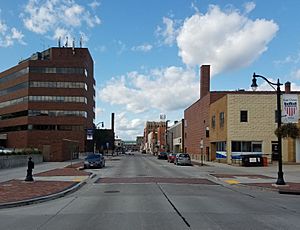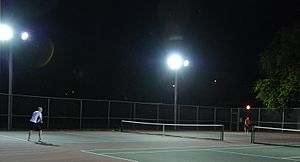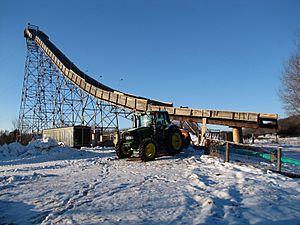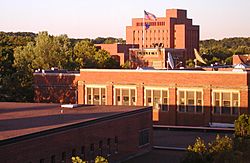Eau Claire, Wisconsin facts for kids
Quick facts for kids
Eau Claire, Wisconsin
|
|
|---|---|
|
City
|
|

Downtown Eau Claire
|
|
| Motto(s):
"Voici l'eau claire!"
("Here is the clear water!") |
|
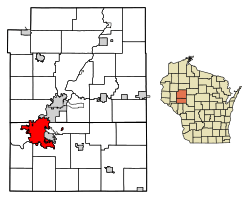
Location of Eau Claire in Eau Claire County
and Chippewa County, Wisconsin. |
|
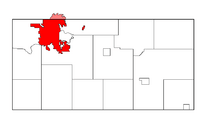
Location within Eau Claire County (pink-shaded portion is within Chippewa County).
|
|
| Country | |
| State | |
| Counties | Eau Claire, Chippewa |
| Government | |
| • Type | Council–manager |
| Area | |
| • City | 34.95 sq mi (90.53 km2) |
| • Land | 32.86 sq mi (85.10 km2) |
| • Water | 2.09 sq mi (5.42 km2) 6.15% |
| Elevation | 787 ft (240 m) |
| Population
(2010)
|
|
| • City | 65,883 |
| • Estimate
(2019)
|
68,802 |
| • Density | 2,093.92/sq mi (808.46/km2) |
| • Metro | 161,151 |
| Time zone | UTC−6 (CST) |
| • Summer (DST) | UTC−5 (CDT) |
| Zip code |
54701-54703
|
| Area code(s) | 715 & 534 |
| FIPS code | 55-22300 |
| GNIS feature ID | 1583124 |
| Website | http://www.eauclairewi.gov |
| Page text. | |
Eau Claire is a city in Eau Claire and Chippewa counties in the west-central part of the U.S. state of Wisconsin. Located almost entirely in Eau Claire County, for which it is the county seat, the city had an estimated population of 68,802 in 2019, making it the state's eighth-largest city. Eau Claire is the principal city of the Eau Claire, Wisconsin Metropolitan Statistical Area, locally known as the Chippewa Valley, and is also part of the larger Eau Claire-Menomonie Combined Statistical Area.
Eau Claire is located at the confluence of the Eau Claire and Chippewa Rivers on traditional Ojibwe, Dakota, and Ho-Chunk land. The area's first permanent European American settlers arrived in 1845, and Eau Claire was incorporated as a city in 1872. The city's early growth came from its extensive logging and timber industries. After Eau Claire's lumber industry declined in the early 20th century, the city's economy diversified to encompass manufacturing and Eau Claire became an educational center with the opening of the University of Wisconsin–Eau Claire in 1916. Eau Claire is also a regional commercial and business center and is home to the headquarters of home improvement store chain Menards.
Eau Claire is known regionally for its arts and music scenes and is the hometown of indie folk band Bon Iver, whose lead singer Justin Vernon co-curates the city's annual Eaux Claires Music & Arts Festival. Eau Claire is the second fastest-growing major city in Wisconsin after Madison, with 5.4% population growth between 2010 and 2020.
Contents
Name origin
Eau Claire took its name from Eau Claire County. "Eau Claire" is the singular form of the original French name, "Eaux Claires", meaning "Clear Waters", for the Eau Claire River. According to local legend, the river was so named because early French explorers journeying down the rain-muddied Chippewa River, happened upon the Eau Claire River, excitedly exclaiming "Voici l'eau claire!" ("Here [is] clear water!"), the city motto, which appears on the city seal. The name is pronounced as if it were spelled "O'Clare".
Geography
Eau Claire is located at 44°49′N 91°30′W / 44.817°N 91.500°W, (44.8146, −91.4927) approximately 90 miles (145 km) east of Minneapolis and St. Paul, Minnesota. The city is located on the northern fringes of the Driftless Zone.
The city was founded near the confluence of the Eau Claire and Chippewa rivers as three separate settlements. The main section of downtown is on the site of the original village, where Stephen McCann, in partnership with J. C. Thomas, put up three buildings in 1845. Although these structures were erected to establish a claim to the land they stood on, the McCann family moved into one of them and became the first permanent settlers. West Eau Claire, founded in 1856, was across the river near the present-day county courthouse, and incorporated in 1872. Between a mile and a half and two miles downstream, the Daniel Shaw & Co. lumber company founded Shawtown, which was annexed by the 1930s. By the 1950s, the entire city had spread far enough to the east to adjoin Altoona.
According to the United States Census Bureau, the city has a total area of 34.14 square miles (88.42 km2), of which 32.04 square miles (82.98 km2) is land and 2.10 square miles (5.44 km2) is water.
The terrain of the city is characterized by the river valleys, with steep slopes leading from the center to the eastern and southern sections of the city. The lands into which the urban area is currently expanding are increasingly hilly.
There are two lakes in the city, Dells Pond, and Half Moon Lake. Dells Pond is a reservoir created by a hydroelectric dam, and was formerly used as a holding pool for logs. Half Moon Lake is an oxbow lake created as part of the former course of the Chippewa River.
| Climate data for Eau Claire, Wisconsin (Eau Claire Regional), 1981–2010 normals | |||||||||||||
|---|---|---|---|---|---|---|---|---|---|---|---|---|---|
| Month | Jan | Feb | Mar | Apr | May | Jun | Jul | Aug | Sep | Oct | Nov | Dec | Year |
| Record high °F (°C) | 54 (12) |
59 (15) |
84 (29) |
91 (33) |
95 (35) |
100 (38) |
111 (44) |
104 (40) |
97 (36) |
89 (32) |
74 (23) |
64 (18) |
111 (44) |
| Average high °F (°C) | 23.4 (−4.8) |
28.9 (−1.7) |
41.1 (5.1) |
57.7 (14.3) |
69.8 (21.0) |
78.6 (25.9) |
82.9 (28.3) |
80.3 (26.8) |
71.4 (21.9) |
57.9 (14.4) |
41.4 (5.2) |
27.1 (−2.7) |
55.0 (12.8) |
| Average low °F (°C) | 5.4 (−14.8) |
9.9 (−12.3) |
21.6 (−5.8) |
34.2 (1.2) |
45.4 (7.4) |
55.3 (12.9) |
60.2 (15.7) |
58.3 (14.6) |
48.9 (9.4) |
36.8 (2.7) |
24.5 (−4.2) |
10.6 (−11.9) |
34.3 (1.2) |
| Record low °F (°C) | −45 (−43) |
−35 (−37) |
−35 (−37) |
5 (−15) |
20 (−7) |
33 (1) |
42 (6) |
37 (3) |
23 (−5) |
11 (−12) |
−18 (−28) |
−32 (−36) |
−45 (−43) |
| Average precipitation inches (mm) | .94 (24) |
.91 (23) |
1.86 (47) |
2.73 (69) |
3.47 (88) |
4.17 (106) |
3.83 (97) |
4.45 (113) |
3.69 (94) |
2.35 (60) |
1.86 (47) |
1.17 (30) |
31.43 (798) |
| Average snowfall inches (cm) | 10.3 (26) |
8.2 (21) |
8.4 (21) |
2.2 (5.6) |
0 (0) |
0 (0) |
0 (0) |
0 (0) |
0 (0) |
.6 (1.5) |
4.6 (12) |
9.9 (25) |
44.2 (112.1) |
| Average precipitation days (≥ 0.01 in) | 9.7 | 8.1 | 9.3 | 11.1 | 12.2 | 12.1 | 11.4 | 10.2 | 11.3 | 10.1 | 9.2 | 10.1 | 124.8 |
| Average snowy days (≥ 0.1 in) | 8.4 | 6.9 | 4.9 | 2.0 | 0 | 0 | 0 | 0 | 0 | .6 | 4.0 | 7.7 | 34.6 |
| Source: NOAA (extremes 1949–present), | |||||||||||||
Demographics
| Historical population | |||
|---|---|---|---|
| Census | Pop. | %± | |
| 1870 | 2,293 | — | |
| 1880 | 10,119 | 341.3% | |
| 1890 | 17,415 | 72.1% | |
| 1900 | 17,517 | 0.6% | |
| 1910 | 18,310 | 4.5% | |
| 1920 | 20,906 | 14.2% | |
| 1930 | 26,287 | 25.7% | |
| 1940 | 30,745 | 17.0% | |
| 1950 | 36,058 | 17.3% | |
| 1960 | 37,987 | 5.3% | |
| 1970 | 44,619 | 17.5% | |
| 1980 | 51,509 | 15.4% | |
| 1990 | 56,856 | 10.4% | |
| 2000 | 61,704 | 8.5% | |
| 2010 | 65,883 | 6.8% | |
| 2020 | 69,421 | 5.4% | |
| U.S. Decennial Census | |||
As of 2000, the median income for a household in the city was $36,399, and the median income for a family was $49,320. Males had a median income of $32,503 versus $23,418 for females. The per capita income for the city was $18,230. About 5.5% of families and 13.6% of the population were below the poverty line, including 10.4% of those under age 18 and 7.4% of those age 65 or over.
In 2017, the median annual household income was $47,660, and the median income for a family was $70,652. The per capita income for the city was $26,605. 17.4% of Eau Claire's population was living in poverty, with the highest prevalence in 18-24-year-old females (26.4%).
2010 census
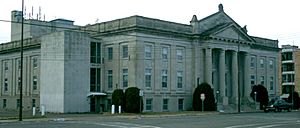
As of the census of 2010, there were 65,883 people, 26,803 households, and 14,293 families residing in the city. The population density was 2,056.3 inhabitants per square mile (793.9/km2). There were 28,134 housing units at an average density of 878.1 per square mile (339.0/km2). The racial makeup of the city was 91.4% White, 4.6% Asian, 1.1% African American, 0.5% Native American, 0.5% from other races, and 1.8% from two or more races. Hispanic or Latino of any race were 1.9% of the population.
There were 26,803 households, of which 25.6% had children under the age of 18 living with them, 39.6% were married couples living together, 9.5% had a female householder with no husband present, 4.2% had a male householder with no wife present, and 46.7% were non-families. 31.7% of all households were made up of individuals, and 10.3% had someone living alone who was 65 years of age or older. The average household size was 2.29 and the average family size was 2.89.
The median age in the city was 29.8 years. 19.3% of residents were under the age of 18; 22.3% were between the ages of 18 and 24; 25.2% were from 25 to 44; 21.7% were from 45 to 64; and 11.7% were 65 years of age or older. The gender makeup of the city was 48.5% male and 51.5% female.
As of 2010, there were 1,981 persons within the city limits in Chippewa County and 63,902 in Eau Claire County for a total of 65,883.
Metropolitan area
The city forms the core of the United States Census Bureau's Eau Claire Metropolitan Statistical Area, which includes all of Eau Claire and Chippewa Counties (composite 2010 population: 161,151). Together with the Menomonie Micropolitan Statistical Area (which includes all of Dunn County) to the west, the Eau Claire metropolitan area, forms the Census Bureau's Eau Claire-Menomonie Consolidated Metropolitan Statistical Area, which had a consolidated 2010 population of 205,008.
Hmong population
As of 2017, Hmong Americans were the largest ethnic minority in Eau Claire. Jenna Christian, Pa Sia Low Moua, and Ingolf Vogeler, the authors of "The Cultural Landscape of the Hmong in Eau Claire, Wisconsin," wrote that the Hmong are also the city's "most visible ethnic group".
In 2010 there were 2,181 Hmong people in Eau Claire County, While the Hmong population is numerically smaller in Eau Claire County compared to Milwaukee, the Hmong have a higher percentage of the population in Eau Claire County, and Christian, Moua, and Vogeler wrote that "the Hmong stand out more singularly as an ethnic minority than they do in metropolitan areas like Milwaukee, which is already more racially and culturally diverse." The majority of the county's Hmong live in the city of Eau Claire. In select Eau Claire neighborhoods, up to 30% of the residents are Hmong.
Transportation
Airports
Eau Claire is served by the Chippewa Valley Regional Airport (KEAU).
Mass transit
- Eau Claire Transit bus lines
Bus
Eau Claire is served by both Greyhound Lines (Milwaukee to Minneapolis, via I-94), and Jefferson Lines Bus service (Green Bay to Minneapolis, via Hwy 29 to I-94).
Major highways
 Interstate 94
Interstate 94 U.S. Route 12 ("Clairemont Avenue")
U.S. Route 12 ("Clairemont Avenue") U.S. Route 53 ("The Bypass")
U.S. Route 53 ("The Bypass")
 Business US-53 ("Hastings Way")
Business US-53 ("Hastings Way") Highway 29 (Bypasses Eau Claire to the north)
Highway 29 (Bypasses Eau Claire to the north) Highway 37 ("Hendrickson Drive")
Highway 37 ("Hendrickson Drive") Highway 85 (Terminates on Wis. 37 just outside Eau Claire)
Highway 85 (Terminates on Wis. 37 just outside Eau Claire) Highway 93
Highway 93 Highway 124 (Foreshortened in 2006, now ends in neighboring Lake Hallie)
Highway 124 (Foreshortened in 2006, now ends in neighboring Lake Hallie) Highway 312 (Signed as, and known locally as, the "North Crossing")
Highway 312 (Signed as, and known locally as, the "North Crossing")
Rail
Eau Claire is located on freight rail lines owned by the Union Pacific Railroad, formerly owned by the Chicago, St. Paul, Minneapolis and Omaha Railway (Omaha Road), and later part of the Chicago and North Western Railway. C&NW operated passenger trains from Chicago through Eau Claire to the Twin Cities area until 1963 when the Twin Cities 400 ended service. Passenger rail service to Eau Claire is seen as critical by the Minnesota Department of Transportation and Wisconsin Department of Transportation, and they plan to return trains to the city by 2030. In March 2021, Amtrak unveiled plans to bring a passenger service to Eau Claire as part of a Milwaukee-to-St. Paul route.
Religion
The Episcopal Diocese of Eau Claire is headquartered in the city. Its mother church is Christ Church Cathedral. The city is also located within the Roman Catholic Diocese of La Crosse and is home to Sacred Heart Church and St. Patrick's Church. Additionally, Community House, First Congregational Church, First Methodist Episcopal Church and the Lutheran Church of the Good Shepherd are located in Eau Claire.

Eau Claire is home to several religious denominations:
- Apostolic Faith – 1 congregation
- Assemblies of God – 2 congregations
- Baptist – 8 churches variously unaffiliated (including 1 SBC congregation)
- Catholic – 5 parishes
- Church of Christ, Scientist (Christian Science) – 1 congregation
- Church of Christ and a non-institutional congregations
- Episcopalian – 1 congregation (The Episcopal Diocese of Eau Claire has its see in Eau Claire.)
- Hmong Christian Alliance – 1 congregation
- Islam – 1 mosque located in Altoona, WI – The Islamic Society of Northern Wisconsin Mosque or Altoona Masjid
- Jehovah's Witness – 2 congregations (both of which share the same Kingdom Hall)
- Judaism – 1 synagogue
- Lutheran – about 20 congregations representing the following:
- Evangelical Lutheran Synod (ELS)
- Evangelical Lutheran Church in America (ELCA)
- Church of the Lutheran Brethren of America
- Lutheran Church – Missouri Synod (LCMS)
- Church of the Lutheran Confession (CLC)
- Wisconsin Evangelical Lutheran Synod (WELS)
- Methodist – 4 congregations (one of which is located in nearby Altoona)
- Lake Street United Methodist Church
- Mennonite Church USA – 1 congregation meeting two Sundays per month
- The Church of Jesus Christ of Latter-day Saints – 1 congregation
- Nazarene – 1 congregation
- Pentecostal – about 10 variously affiliated congregations
- Presbyterianism – 2 congregations
- Society of Friends (Quakers) – 1 congregation
- Salvation Army – 1 congregation
- Unitarian Universalist – 1 congregation
- United Church of Christ – 3 congregations
- Unity School of Christianity – 1 congregation
- Wesleyan Church – 1 congregation
Recreation
There are several large parks in the city: Owen Park, along the Chippewa River, home to a large bandshell where open-air concerts are held throughout the summer; Putnam Park, which follows the course of Putnam Creek and Little Niagara Creek east from the UWEC campus; Carson Park, situated in the middle of an oxbow lake; and Phoenix Park on the site of the old Phoenix Steel plant at the confluence of the Eau Claire and Chippewa River. Phoenix Park is the host of a weekly farmers market and open-air concerts during summer months. Riverview Park is also a common summer swimming destination, as well as one of the local boat landings. This park includes picnicking areas and grills, as well as public restrooms.
The City of Eau Claire also operates Fairfax public pool, and Hobbs Municipal Ice Center, an indoor ice center.
Eau Claire is at the head of the Chippewa River State Trail, a biking and recreation trail that follows the lower course of the Chippewa River.
Recognition
America's Promise named the city as one of the 100 Best Communities for Young People in 2007. Eau Claire was among the first Tree Cities in Wisconsin, having been recognized as such since 1980.
Sister cities
Eau Claire is sistered with the following towns:
 Lismore, New South Wales, Australia
Lismore, New South Wales, Australia Miramar, Costa Rica
Miramar, Costa Rica
Economy
Eau Claire styles itself as the "horseradish capital of the world", due to the presence of Silver Spring Foods, the world's largest grower and producer of horseradish. The climate, with its cool winters, is conducive to the horseradish crop. Other significant crops grown in the area are apples, pumpkins and plums. Menards, a Midwestern chain of home improvement stores owned by Wisconsin native John Menard, Jr., is headquartered in Eau Claire.
Sports
Baseball
Eau Claire has three amateur baseball teams. The Eau Claire Express are a team that plays in the Northwoods League, an NCAA-sanctioned summer baseball league. Their home games are played at Carson Park. The Eau Claire Cavaliers, also plays home games at Carson Park. The Eau Claire Bears play in the Chippewa River Baseball League. Also, three of Eau Claire's High Schools have baseball teams. Eau Claire North H.S. won the 2011 and 2019 state championship. Eau Claire also has a large youth baseball program including a summer parks and recreation league, Little League (Nationals, American, Lowes Creek and Seymour). Eau Claire Little League teams have twice won the state championship (1998 Eau Claire Americans and 2012 Eau Claire Nationals) and advanced to Regional play in Indianapolis, IN. A Babe Ruth League (13- to 18-year-olds) which won State Tournaments at ages 13, 14 and 15 in 2012. Those Teams all went on to win 3rd place at their Regional Tournaments.
Curling
Eau Claire Curling Club has been around for 64 years.
Football
The Chippewa Valley Predators football compete in the Northern Elite Football League, play their home games at Carson Park. Their team was established in 2001. The Northern Lights Cowboys compete in the Champions Amateur Football League and play their home games at Carson Park.
Roller Derby
Established in 2009, The Chippewa Valley Roller Girls (CVRG) represent Eau Claire and the surrounding Chippewa Valley region. CVRG, a WFTDA League member, is Eau Claire's original all-female flat track roller derby league. It is a non-profit organization managed and operated by the skaters via an elected board of directors and skater-led committees.
Soccer
Bateaux FC, an amateur soccer club, is based in the city. The club is a founding member of the Wisconsin Primary Amateur Soccer League (WPASL), a USASA and WSL-sanctioned league operating in western Wisconsin.
Eau Claire United is a competitive youth soccer team competing in the MYSA. Every summer, Eau Claire United hosts a soccer tournament that brings around 100 teams to the community.
Kubb
The U.S. National Kubb Championship is held in Eau Claire annually. The Eau Claire Kubb League operates kubb league year round.
Tennis
The John and Fay Menard YMCA Tennis Center (2017) has 8 indoor courts and hosts several sectional and national tournaments. Jan 8-14th the facility will host an ITF J5 tournament attracting players from all over the world.
Horseshoes
Eau Claire hosted the World Horseshoe Championship in 2003, and the Wisconsin State Horseshoe Tournament in 2019.
Ski jumping
Each January, Eau Claire hosts the Silver Mine ski jump Invitational. In February 2021, the 135th annual Silver Mine Ski Jump competition will take place.
Education
Eau Claire schools are part of the Eau Claire Area School District. The city has two public high schools: Memorial High School and North High School; and two public charter high schools: McKinley Charter School and Technology Charter School. Eau Claire also has two private high schools: Catholic Regis High School and Immanuel Lutheran High School.
Eau Claire is home to two public colleges (University of Wisconsin–Eau Claire and the Chippewa Valley Technical College) and one private college (Immanuel Lutheran College).
There are 13 elementary schools, and 3 middle schools in the Eau Claire Area School District. In addition, there is the Chippewa Valley Montessori Charter School, which was founded in 2002, and follows the teaching of Maria Montessori.
Notable people
Images for kids
-
The Sarge Boyd Bandshell in Owen Park is listed on the National Register of Historic Places. Built in 1938 to showcase the Eau Claire Municipal Band, it remains the city's premier outdoor performance venue.
See also
 In Spanish: Eau Claire (Wisconsin) para niños
In Spanish: Eau Claire (Wisconsin) para niños





